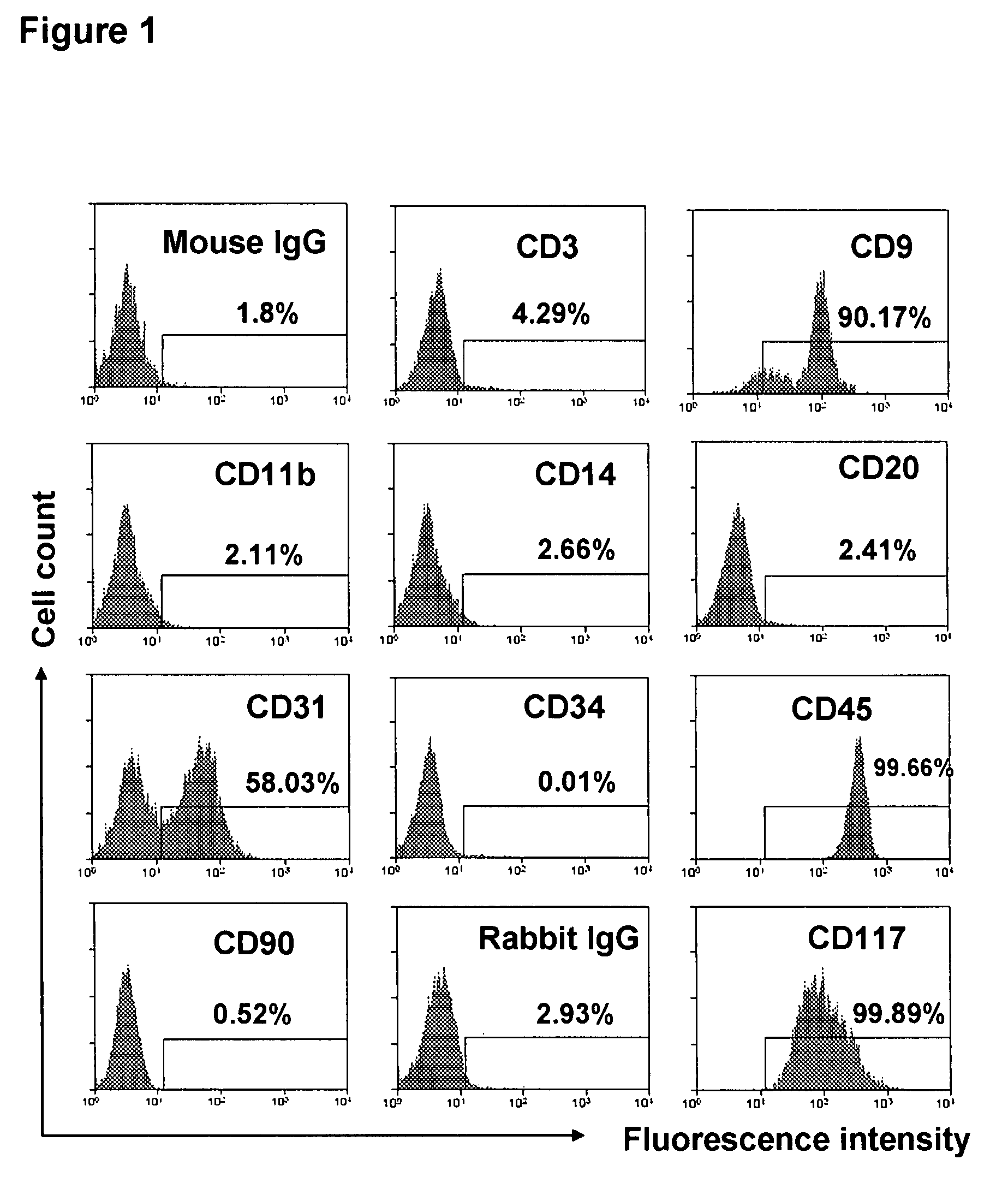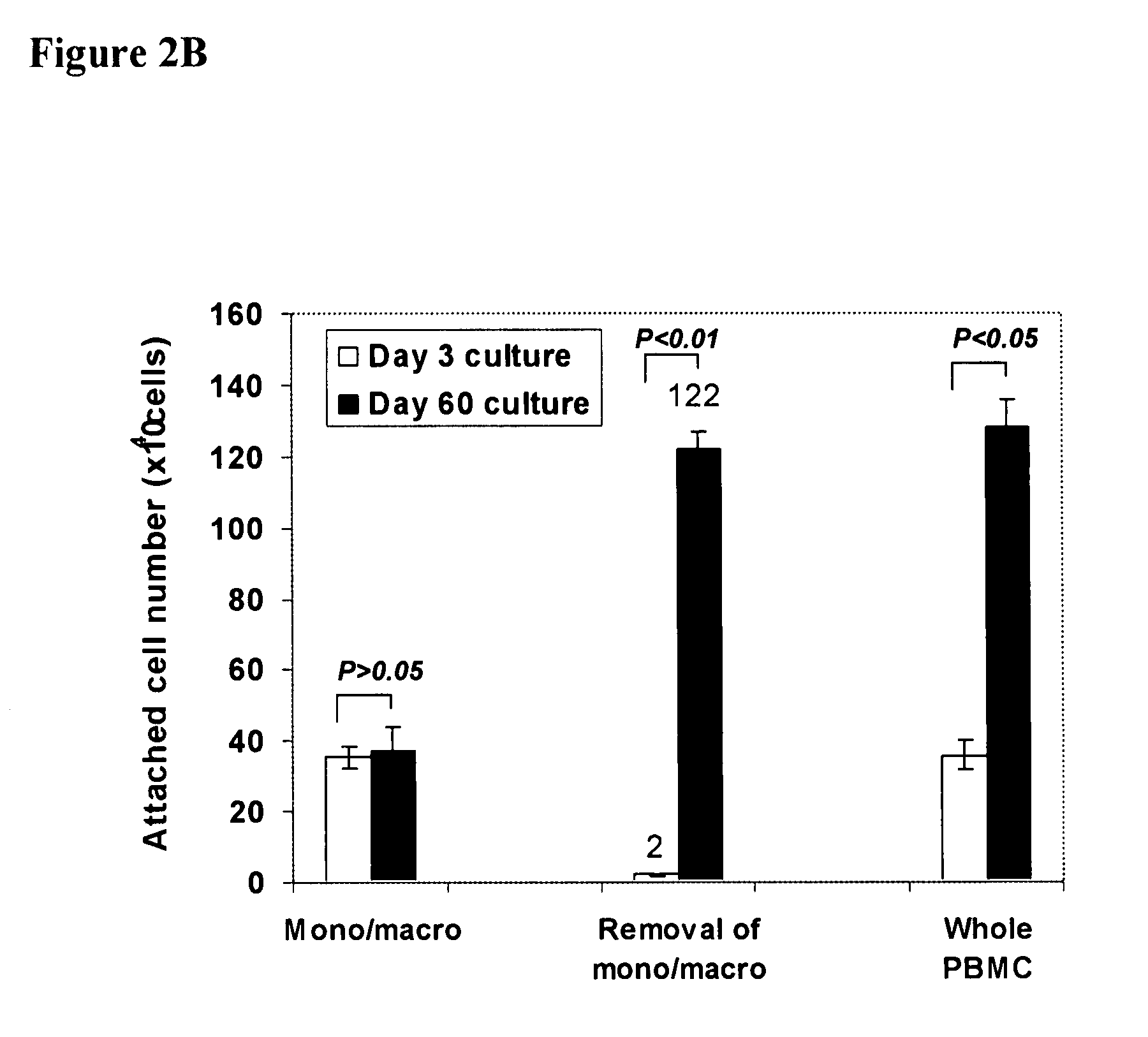Embryonic-like stem cells derived from adult human peripheral blood and methods of use
a technology which is applied in the field of embryonic-like stem cells obtained from adult human peripheral blood, can solve the problems of limited availability and practical usefulness of es cells, scarcity of previously-described cell populations, and complex requirements of required technologies, so as to reduce intracellular il-10 levels, inhibit proliferation, and increase expression of cd69
- Summary
- Abstract
- Description
- Claims
- Application Information
AI Technical Summary
Benefits of technology
Problems solved by technology
Method used
Image
Examples
example 1
Isolation of Embryronic-like Stem Cells from Adult Human Peripheral Blood
Cell Culture
[0099]Human buffy coats (50-60 ml / unit) were obtained from 10 healthy donors (6 male and 4 female), aged 20-62 years (averaged 45±13) (Life-Source Blood Services, Glenview, Ill.). Mononuclear cells were isolated using Ficoll-Hypaque (γ=1.077, Sigma), followed by removing red blood cells using Red Blood Cell Lysis buffer (eBioscience, San Diego, Calif.). PB-SC culture was performed as previously described [Y. Zhao, H. Wang, T. Mazzone. Exp Cell Res. 312, 2454 (2006)]. Briefly, mononuclear cells were seeded into the 8-Well Lab-Tek II Chamber Slide (Fisher Scientific) at 1×105 cells / ml, 0.5 ml / well in RPMI 1640 medium supplemented with 7% fetal bovine serum (Invitrogen, Carlsbad, Calif.), and incubated at 37° C., 8% CO2 conditions. To expand cells in a large scale, mononuclear cells were initially seeded in the 150×15 mm Style Petri dishes (Becton Dickinson Labware, Franklin Lakes, N.J.) at 1×106 cells...
example 2
PB-SC Differentiate to Insulin-Producing Cells to Treat Hyperglycemia in a Diabetic Mammalian Subject
[0109]Diabetes in NOD-scid male mice, aged 8-10 weeks, was induced with a single intraperitoneal injection of streptozotocin (STZ) (Sigma) 180 mg / kg of body weight, freshly dissolved in citrate buffer (pH=4.5). Blood glucose levels were evaluated daily between 9 and 11 A.M. under nonfasting conditions. Severe diabetes was confirmed by the presence of weight loss, polyuria, and nonfasting blood glucose levels >450 mg / dl for 2 consecutive days, and then used for transplantation, according to a protocol approved by the Animal Care Committee (ACC) of University of Illinois at Chicago. In brief, PBSC at dosage of 5 million cells / mouse in 0.5 ml physiological saline was injected into the peritoneal cavity by injection with 27-gauge needle, normally on day 3 following the injection of streptozotocin. The control mice were injected only with an equal volume of physisological saline. Blood gl...
example 3
PB-SC Express Insulin Gene Transcription Factors
[0117]As shown in FIG. 6A, we observed that PB-IPC could proliferate and significantly increased in cell number. To evaluate the insulin-producing capability of the PB-IPC, we examined the insulin gene transcription factors such as the basic leucine zipper MafA, Pdx-1(pancreatic duodenal homeobox factor 1), NeuroD1 (neurogenic differentiation 1), HNF6 (hepatocyte nuclear factor 6, also known as Onecut1), Nkx6.1 (Nk homeobox gene), and Nkx2.2. We found that PB-IPC significantly expressed these transcription factors and increased their levels in comparison with PBMC (FIG. 6B); specifically for the β cell specific transcription factor MafA expression, immunostaining showed that 93±2% of PB-IPC strongly displayed nuclear staining for MafA (data not shown). MafA is a very specific insulin gene transcription factor for islet beta cells (Matsuoka T A, et al. Proc Natl Acad Sci USA. 2004; 101: 2930-2933); thus its expression indicates that the...
PUM
| Property | Measurement | Unit |
|---|---|---|
| volume | aaaaa | aaaaa |
| hydrophobic | aaaaa | aaaaa |
| permeable | aaaaa | aaaaa |
Abstract
Description
Claims
Application Information
 Login to View More
Login to View More - R&D
- Intellectual Property
- Life Sciences
- Materials
- Tech Scout
- Unparalleled Data Quality
- Higher Quality Content
- 60% Fewer Hallucinations
Browse by: Latest US Patents, China's latest patents, Technical Efficacy Thesaurus, Application Domain, Technology Topic, Popular Technical Reports.
© 2025 PatSnap. All rights reserved.Legal|Privacy policy|Modern Slavery Act Transparency Statement|Sitemap|About US| Contact US: help@patsnap.com



